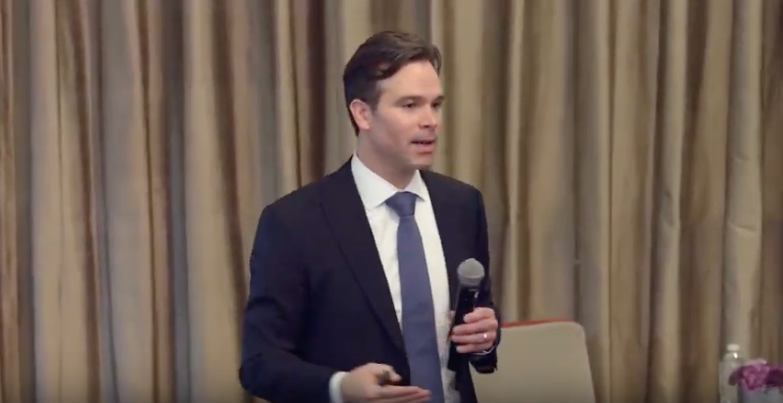
Michael McWilliams was the keynote speaker at the 21st Annual Kovner-Behrman Health Forum at the NYU Wagner Graduate School of Public Service, with a talk titled “Accountable Care Organizations: Making Progress in a Land of Unicorns.”
In his speech, McWilliams tackled the core issues around his work studying ACOs: the myths, the realities and the greatest challenges ahead in payment and delivery system reform.
Are ACOs unicorns, spreading cost-saving magic through the health care system?
That sounds nice, but not exactly. Essentially, ACOs are a new spin on an old idea—a risk contract with a payer (in the work McWilliams does, usually Medicare), a group of providers, a global budget called a benchmark and a set of risk-sharing provisions. There’s also a quality component, with a reward for high performance on a set of quality measures. The majority of contracts in the Medicare Shared Savings Program (the largest Medicare ACO program) are one-sided, meaning the ACO isn’t held accountable and penalized for spending in excess, although certain programs like the Medicare Pioneer model hold ACOs accountable for spending in excess of benchmarks. The cost-saving magic that many expected from ACOs is their potential ability to better coordinate and manage care, thereby preventing costly complications, smoothing transitions in care, eliminating redundancies, and promoting health. The widespread assumption has been that these efforts could yield savings.
Have ACOs achieved savings?
Yes—the savings are modest but growing over time. Entrants that joined the program later on seem to be taking more time to develop savings, but by 2014, the earliest entrants had reduced Medicare spending by 3.1% after less than 3 years of participation. Overall, the Medicare Shared Savings Program saved Medicare $287 million by the end of 2014, even after accounting for the shared-savings bonuses paid out by Medicare to the ACOs. This figure amounts to just 0.7% of Medicare spending for ACO patients, but it probably underrepresents how much is actually being saved. After account for spillover effects, which in this case means that these savings are reducing fee-for-service care and potentially impacting on a system level, the net savings to Medicare were closer to $700 million. These numbers are not home runs, “but there are no home runs in health care,” says McWilliams. “This is a good single. And we need more of them.”
Interestingly, the pattern of savings across different types of care suggests that it’s not necessarily care coordination that’s causing the savings, nor is it due to improving outcomes or performance on quality measures.
Then how have ACOs saved?
The real key is to target high spending on tests and services that are not needed, i.e., low-value care. Organizations that have demonstrated efficiency have done so through wholesale system changes. Developing practice patterns and a certain values-oriented brand of medicine seems to make much more of a difference than care management programs targeting specific patients. And contrary to the widespread notion that ACOs need to provide the full continuum of patient care to coordinate care and generate savings, it has been the smaller independent physician groups who have led the way in terms of savings. Big health systems have weaker incentives to cut spending because they provide (and thus receive fee-for-service revenue from) the care that should be cut. Post-acute care is an area where almost no ACOs provide a lot of care, where there has been a lot of wasteful care in Medicare, and where ACO savings have been particularly prominent. As McWilliams says, “The savings track with the strength of incentives.”
What are the major challenges in moving forward?
One big challenge is taking the incentives established by ACO contracts at the organizational level and transmitting them to the physician level to change physician behavior and improve patient outcomes. Other challenges are regulatory in nature. For example, how can payment systems promote high quality are and discourage stinting on valuable care while also encouraging lower spending? With any program, providers could begin to “teach to the test,” i.e., begin to tailor their behavior to specific measures without making true differences in the quality of care. McWilliams argues that greater use of surveillance and cutting the patients in on bonuses for high quality are promising directions.
Inadequate risk adjustment is another issue, which causes providers to seek out healthier, less expensive patients. To a degree, says McWilliams, we can’t know everything about a patient, so risk adjustment is only so helpful, but more importantly compensating for higher-spending patients can incentivize providers to take them on and mitigate the threat of exacerbating disparities.
It’s also critical to keep markets competitive, which is key for payment models to work. McWilliams’s work suggests that ACOs aren’t driving much consolidation, contrary to popular assumptions, but consolidation is allowing providers to charge higher prices with less emphasis on care quality. Paying more doesn’t get you more, so newer payment models shouldn’t necessitate less competition.
Finally, regulators and payers need to have a long view when designing and harmonizing different payment models, as they can work at cross-purposes. Bundling services, which has become a popular payment model, could entrench the market power of hospitals and specialists and weaken incentives for ACOs to reduce wasteful care by allowing hospitals and specialists to keep the savings. Too much innovation at the same time, McWilliams argues, may be hampering successes.
“We’re at a critical time in ACOs—there’s a narrow opportunity to chart the right course,” says McWilliams. It’s important to remove some of these critical assumptions that are hindering the success of developing ACOs, assumptions that have become difficult to dislodge. It’s important to keep in mind, McWilliams concludes, “that unicorns don’t exist.”
Enjoy content like this? Sign up for our newsletter and follow HCP on Twitter.
Photo: NYU Wagner